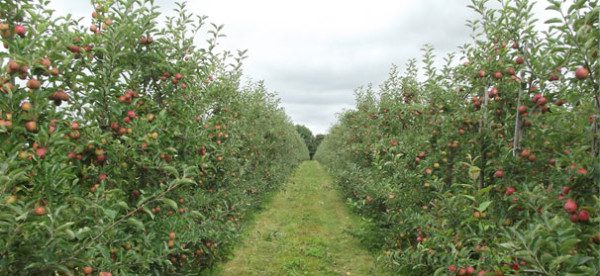

Nov 4, 2011Orchard makes organic apples work in Britain
The demand for organic apples is fairly high in the United Kingdom – higher, in fact, than native growers can supply. Only about a tenth of the organic apples consumed in the country were actually grown in the country, said Jerry Cross, an entomologist and professor at East Malling Research (EMR), East Malling, England.
“We don’t grow enough organic apples,” Cross said. “It’s a very small industry.”
There might be a dozen growers in the country who actually make a living producing organic apples, he said.
In late July, Cross showed visitors from the International Fruit Tree Association (IFTA) one of EMR’s organic apple orchards, which were planted a few years ago – not just as an experiment, but as a commercial venture. So far, yields have been low and weed control difficult, he said.
Later in the tour, however, the IFTA group got to see another organic orchard, one that’s getting good yields while managing to fight off pests.
H.E. Hall & Son, Marden, England, a family farm that’s been around since the 1890s, planted a 4-hectare (roughly 10-acre) organic apple orchard in April 2007, at the behest of apple supplier OrchardWorld Ltd. The farm already grew apples and pears at the time, and since organic pest-fighting techniques had improved by leaps and bounds in the preceding few years, owner Peter Hall felt the venture had a reasonable chance of success, according to the farm’s website.
Hall, who considers himself more of an ecologist by nature than a grower, wants to improve the reputation organic fruit has of being “high-price and low-quality,” but he wants to do it using “science and technology, not muck and magic.”
“There’s so much smoke and mirrors with organics,” he said.
The farm’s organic crops (including grapes and hops) are certified by The Soil Association, probably the “gold standard” certifying body in the United Kingdom, he said.
Hall planted the organic apple orchard on heavy clay soil, the “best bit of ground” he had, he said. It’s a super-intensive planting based on the Dutch table-top system. There are 3,000 trees per hectare (compared with about 1,000 per hectare in the farm’s conventional, semi-intensive systems) planted on a wire and post support system under full trickle irrigation, according to the website.
“This level of tree planting is the only way that such a capital-intensive system can quickly achieve the very high yields required to make it a financially viable option,” according to the website.
As for varieties, Hall wanted to grow organic apples people would actually eat, instead of “weird and wonderful stuff you’ve never heard of” – varieties that might be a bit tolerant to disease, but “when you taste it, you very quickly work out why” it’s not popular, he said.
Gala and Braeburn are easily the two most popular varieties in the United Kingdom, so planting those was a no-brainer. Hall also went with Bramley, a big cooking apple popular in the United Kingdom that has high acid and sugar levels and a “wonderful sweet/sour balance,” he said.
Hall planted Cox initially, but that variety never grew well in the orchard, for reasons he could never figure out. The trees looked fantastic, but the fruit ended up russeted and cracked. They took the Cox trees out last year and replaced them with more Gala and Braeburn, he said.
Of course, the most popular varieties aren’t necessarily the most resistant to pests and diseases – especially without the aid of modern chemistry, he said. But organic growers have more tools at their disposal these days.
To fight apple scab, there are two electronic weather stations on the farm, which continuously record rainfall, moisture, temperature, humidity – “all the usual jazz.” The data is fed through a computer model that predicts scab conditions in an easy-to-interpret manner, he said.
“This allows exact and timely treatments of sulfur to be applied during the early growing season,” according to the website.
Soap works well against aphid pests and apple sucker, he said.
“Insects won’t evolve their way out of being drowned.”
Codling moth is another challenge for the organic orchard, but thanks to pheromone mating disruption, it can be managed. Hall explained the method to his IFTA visitors. Interspersed throughout the orchard are boxes filled with “female codling moth Chanel No. 5.” Once a male codling moth gets a whiff, he floats into the box, thinking there’s a gravid female inside, Hall said.
“He blunders about looking for this delicious girl,” and while doing so gets covered in the female scent. “He then flies out smelling like one of the girls,” which gets the attention of the other guys, Hall said.
Some say that when a real codling moth female is out there, the males can tell the difference, but Hall isn’t so sure.
“It’s taken them 500 million years to evolve by way of finding each other, so they ain’t gonna evolve their way out of it,” he said.
Thanks to these techniques and others, most of the organic orchard’s varieties have been yielding extremely well – better than in a conventional setting, in some cases. Most of the organic apples end up at Sainsbury’s supermarkets, where they fetch a nice premium, Hall said.
The success of the orchard has made it a magnet for curious scientists and growers.
“No one was expecting it to look like this,” he said. “People thought it would be a disaster.”
Check out the video here.
by Matt Milkovich, Managing Editor














